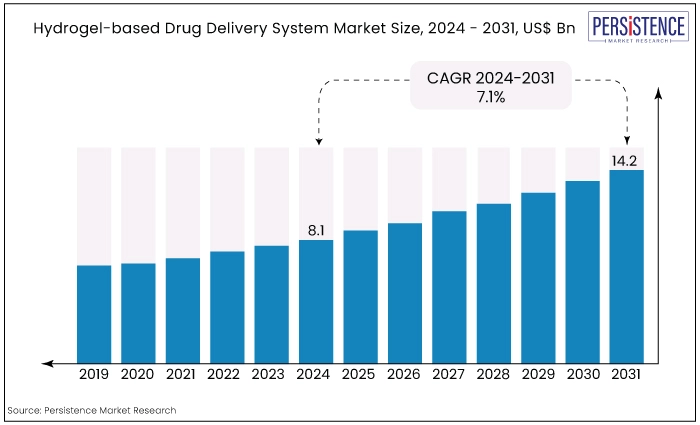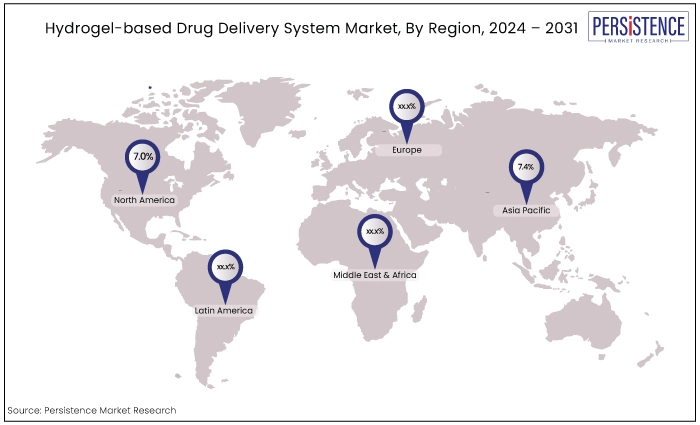Industry: Healthcare
Published Date: August-2024
Format: PPT*, PDF, EXCEL
Delivery Timelines: Contact Sales
Number of Pages: 195
Report ID: PMRREP34676
The global market is estimated to value at US$14.2 Bn by the end of 2031 from US$8.1 Bn recorded in 2024. The market is expected to secure a CAGR of 7.1% in the forthcoming years from 2024 to 2031.
Key Highlights of the Market
|
Market Attributes |
Key Insights |
|
Hydrogel-based Drug Delivery System Market Size (2024E) |
US$8.1Bn |
|
Projected Market Value (2031F) |
US$14.2 Bn |
|
Forecast Growth Rate (CAGR 2024 to 2031) |
7.1% |
|
Historical Growth Rate (CAGR 2018 to 2023) |
6.4% |
Hydrogels are unparalleled in their ability to deliver drugs in a targeted and controlled manner. They can be tailored to release medications at a specific rate and location within the body, thereby reducing side effects and maximizing the therapeutic benefit for patients.
The global hydrogel-based drug delivery system market is witnessing significant growth due to the rising demand for targeted and controlled drug delivery solutions.
Hydrogels, three-dimensional polymer networks capable of holding large amounts of water, have emerged as promising carriers for various therapeutic agents. Their unique properties, such as high water content, biocompatibility, and the ability to respond to different physiological stimuli, make them ideal candidates for drug delivery applications.
Hydrogel-based drug delivery systems are designed to significantly enhance drug efficacy and safety. By controlling the release rate and targeting specific tissues or organs, these systems can be engineered to respond to changes in pH, temperature, or specific enzymes, ensuring precise drug release in response to the body’s needs.
The targeted delivery not only reduces the side effects commonly associated with conventional drug administration methods but also enhances patient compliance and outcomes, thereby improving overall treatment effectiveness.
The market is driven by the increasing prevalence of chronic diseases such as cancer, diabetes, and cardiovascular disorders, which require long-term treatment and controlled drug release. Additionally, the growing aging population and the need for minimally invasive treatment options are contributing to the demand for advanced drug delivery systems.
Technological advancements in hydrogel formulations and crosslinking methods are further propelling market growth, enabling the development of more efficient and versatile drug delivery platforms.

The global market has experienced significant growth, driven by advancements in drug delivery technologies and increased demand for controlled release systems. Historically, the market saw steady growth due to innovations in hydrogel formulations enhancing drug stability and efficacy.
The market is thriving, supported by rising investments in R&D and the growing prevalence of chronic diseases requiring advanced drug delivery methods. Key players focus on developing novel hydrogel-based systems for targeted and sustained release.
The market is poised for further expansion, fueled by ongoing research, technological breakthroughs, and the integration of nanotechnology. The future landscape will likely witness more personalized and efficient drug delivery solutions, catering to the evolving needs of the healthcare industry. This trajectory highlights the market's potential to revolutionize therapeutic strategies globally.
Growing Chronic Disease Prevalence
The market is experiencing significant growth due to the increasing prevalence of chronic diseases. Hydrogels are three-dimensional networks of hydrophilic polymers that can absorb and retain large amounts of water, making them ideal for controlled drug delivery.
The unique properties of hudrogels allow for sustained and targeted release of therapeutic agents, which are particularly beneficial for managing chronic conditions like diabetes, cancer, and cardiovascular diseases.
Chronic diseases are becoming more prevalent worldwide, driven by factors such as aging populations, lifestyle changes, and environmental influences. This rise in chronic conditions propels the demand for advanced drug delivery systems that offer improved efficacy and patient compliance.
Hydrogel-based systems are increasingly favored for their biocompatibility, ability to encapsulate various drugs, and potential for reducing side effects.
The hydrogel-based drug delivery systems market is expected to grow as research and development efforts continue to innovate and enhance these technologies. Innovations include smart hydrogels that respond to specific physiological conditions, offering personalized treatment options.
As the global burden of chronic diseases increases, hydrogel-based drug delivery systems are set to play a pivotal role in providing effective and efficient therapeutic solutions, underscoring their value in managing chronic diseases.
Increasing Demand for Targeted and Controlled Release of Drugs
The global market is being driven by the increasing demand for targeted and controlled drug release. Hydrogels are advanced drug delivery carriers known for their high water content, biocompatibility, and ability to release therapeutic agents in a controlled manner. This makes them highly effective for achieving precise drug delivery, which is crucial for treating chronic conditions and managing complex diseases.
As the medical field evolves, there is a growing emphasis on therapies that can deliver drugs specifically to targeted sites within the body, minimizing systemic side effects and improving patient outcomes.
Hydrogels are uniquely suited to this demand because they can be engineered for site-specific drug release and respond dynamically to changes in the body’s environment, such as pH or temperature. This capability aligns well with the need for more effective treatments in chronic disease management, where traditional drug delivery methods may fall short.
Additionally, the versatility of hydrogels allows for the incorporation of various drugs, including proteins, peptides, and small molecules, further driving their adoption in diverse therapeutic areas. As a result, the market is poised for robust growth, driven by technological advancements and the escalating need for sophisticated drug delivery solutions.
Limitations of Hydrogel-Based Drug Delivery Systems
Hydrogel-based Drug Delivery System Market offer numerous advantages, but they also face several limitations. One major limitation is their potential for limited mechanical strength, affecting their stability and drug release profile, particularly in dynamic physiological environments.
Hydrogels are often sensitive to environmental changes such as temperature and pH, impacting their performance and reproducibility. Additionally, the drug release from hydrogels can be challenging to control precisely, especially for drugs requiring a sustained release over an extended period.
Another limitation is the potential for limited drug-loading capacity due to the hydrogel's structure, which may restrict the amount of therapeutic agent that can be incorporated. The biocompatibility of some hydrogels can also be a concern, as certain materials may provoke immune responses or cause toxicity.
Furthermore, scaling up the production of hydrogel-based systems from laboratory to industrial scale can take time and effort. These factors need to be addressed to enhance the efficacy and practicality of hydrogel-based drug delivery systems.
Enhancing Performance with Nanotechnology Integration
The global system market holds significant opportunities through integrating nanotechnology, which promises to enhance performance and expand applications. Nanotechnology can revolutionize hydrogel-based systems by improving drug delivery capabilities and therapeutic outcomes.
By incorporating nanoparticles into hydrogels, researchers can create hybrid systems with enhanced properties such as increased drug loading capacity, targeted delivery, and controlled release.
Nanoparticles can be engineered to respond to specific physiological conditions, enabling precise and localized drug release that minimizes side effects and improves treatment efficacy.
Moreover, nanotechnology allows for the development of intelligent hydrogels that can adjust their drug release profiles in response to environmental stimuli such as pH changes, temperature variations, or the presence of specific biomarkers.
This responsiveness enhances the adaptability and effectiveness of drug delivery systems, making them suitable for a broader range of applications. The synergy between hydrogels and nanotechnology not only opens doors for new therapeutic areas and innovative treatment options but also promises substantial growth and innovation.
As research and development progress, the integration of nanotechnology is set to drive significant growth and innovation in the market.
Growing Demand for Personalized Medicine
Hydrogel-based drug delivery systems increasingly align with the growing demand for personalized medicine, offering tailored therapeutic solutions to individual patients.
Hydrogels, with their high water content and biocompatibility, can be engineered to respond to specific physiological conditions, allowing for customized drug release profiles. This adaptability suits them for personalized medicine, where treatments are adjusted based on individual needs and disease states.
These systems can be designed to release drugs in response to specific triggers, such as pH changes or enzyme activity, which are unique to each patient’s condition. This ensures the medication is delivered precisely where and when needed, improving efficacy and minimizing side effects.
Additionally, hydrogels can be formulated to accommodate different drug types and dosages, further supporting personalized treatment strategies.
As personalized medicine continues to expand, the flexibility and adaptability of hydrogel-based systems are poised to be a driving force in their increasing adoption. These systems have the potential to significantly enhance targeted therapy and individualized patient care, shaping the future of medicine.
|
Category |
Projected CAGR through 2031 |
|
Polymer Origin-Synthetic |
7.2% |
|
Delivery Route-Oral Cavity |
6.9% |
Synthetic Polymer Holds a Substantial Market Share
Due to its versatile properties and performance advantages, the synthetic segment commands a substantial share in the market. Synthetic hydrogels are engineered to have precise, reproducible characteristics crucial for consistent drug delivery.
Compared to natural hydrogels, they offer superior control over mechanical strength, degradation rates, and drug release profiles. Additionally, synthetic hydrogels can be tailored to respond to specific physiological triggers or deliver a wide range of drugs, enhancing their functionality.
Synthetic hydrogels' ability to be customized for various applications, including targeting specific tissues or conditions, makes them highly valuable in advanced therapeutic strategies.
The scalability of synthetic hydrogel production also contributes to their significant market share, as they can be manufactured in larger quantities with consistent quality. This combination of tailored properties and production efficiency drives the growth of the synthetic segment in the hydrogel-based drug delivery market.
Oral Cavity Segment Dominant Delivery Route
Due to its ease of administration and patient convenience, the oral cavity segment is the dominant delivery route in the market. Hydrogels designed for oral delivery can adhere to mucosal surfaces, allowing for localized or systemic drug release with minimal discomfort. This method is particularly advantageous for delivering medications that require sustained release or targeted therapy directly to the oral cavity or gastrointestinal tract.
Hydrogels in this segment are engineered to maintain their structure and functionality in the challenging oral environment, providing controlled release and enhancing therapeutic efficacy.
The ability of these hydrogels to encapsulate drugs effectively while ensuring biocompatibility makes them a preferred choice for oral drug delivery. This contributes to the segment’s dominance, aligning with the growing demand for non-invasive, patient-friendly treatment options.
|
Region |
CAGR through 2034 |
|
North America |
7.0% |
|
Asia Pacific |
7.4% |
North America’s Gains Lie in Advanced Healthcare Infrastructure
North America is poised to account for a significant share in the market, driven by advanced healthcare infrastructure, and high investment in research and development.
The region's strong emphasis on innovative medical technologies and its well-established pharmaceutical and biotechnology industries contribute to its leading position. Additionally, North America's substantial healthcare spending supports adopting cutting-edge drug delivery systems.
The presence of significant market players and numerous ongoing clinical trials further bolster the region's market share. North American regulatory frameworks are also conducive to the development and commercialization of hydrogel-based systems, ensuring that new technologies can be rapidly introduced and scaled.
North America thus remains a crucial hub for the growth and innovation in hydrogel-based drug delivery solutions.
Asia Pacific Sets Eyes on a CAGR of 7.4% Through 2031
The Asia Pacific region is experiencing rapid expansion in the market, driven by increasing healthcare expenditures and improving medical infrastructure.
Economic growth, and rising disposable incomes have led to higher investments in healthcare across countries like China, India, and Japan. This surge in spending supports the adoption of advanced drug delivery technologies, including hydrogels.
Governments and private sectors heavily invest in research and development, fostering innovation, and introducing new hydrogel-based therapies. The region's growing population also demands effective and patient-friendly drug delivery systems.
Additionally, a skilled workforce and cost-effective manufacturing capabilities enhance the market's growth prospects. These factors collectively contribute to the robust expansion of the market in the Asia Pacific region.

June 2023
Bausch + Lomb announced the US debut of its Bausch + Lomb Infuse Multifocal silicone hydrogel (SiHy) daily disposable contact lenses. These lenses are crafted with an innovative material infused with ProBalance Technology to ensure all-day comfort. Featuring the company's '3-Zone Progressive' design, the lenses cater to patients with presbyopia by providing clear vision across near, intermediate, and distance ranges, while also working to reduce contact lens dryness.
November 2023
Materials engineers at Stanford University have developed a novel hydrogel drug delivery system that reduces the frequency of injections for diabetes and weight control medications-such as Ozempic, Mounjaro, Trulicity, and Victoza-from daily or weekly to just once every four months.
|
Attributes |
Details |
|
Forecast Period |
2024 to 2031 |
|
Historical Data Available for |
2018 to 2023 |
|
Market Analysis |
US$ Billion for Value |
|
Key Regions Covered |
|
|
Key Market Segments Covered |
|
|
Key Companies Profiled in the Report |
|
|
Report Coverage |
|
|
Customization & Pricing |
Available upon request |
By Polymer Origin
By Region
To know more about delivery timeline for this report Contact Sales

The demand for hydrogel-based drug delivery systems is surging due to their controlled release properties, biocompatibility, patient convenience, and adaptability to personalized medicine and various therapeutic applications.
Innovations such as stimuli-responsive hydrogels, advanced biocompatible materials, targeted drug delivery mechanisms, and integration with nanotechnology are shaping the market.
Regulations governing hydrogel-based drug delivery systems include FDA guidelines, EMA standards, and ISO certifications, ensuring safety, efficacy, and quality in medical and pharmaceutical applications.
Future trends in the hydrogel-based drug delivery system market include personalized medicine, smart hydrogels, bioprinting integration, and enhanced biocompatibility for advanced therapeutic applications.
North America is expected to account for a significant share of the market.